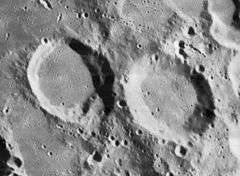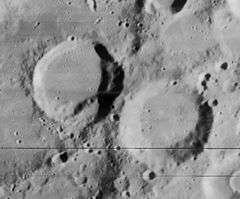Rost (crater)
Rost is a lunar impact crater that is located in the southwestern part of the Moon, to the southeast of the elongated formation Schiller. To the southeast of Rost is the larger crater Scheiner. West-southwest of this formation is the smaller Weigel.
 Lunar Orbiter 4 image of Rost (right) and Rost A (left) | |
| Coordinates | 56.4°S 33.7°W |
|---|---|
| Diameter | 48 km |
| Depth | 2.0 km |
| Colongitude | 35° at sunrise |
| Eponym | J. Leonhard Rost |

This crater is a circular formation with a low rim and a relatively featureless inner wall and interior floor. There are some tiny craterlets around the rim, including one across the northwest wall and another on the inner wall to the south. The interior has no significant features, with only a tiny craterlet to mark the surface.
Rost lies east of the Schiller-Zucchius Basin, and the outer rim of the basin lies between Rost and Rost A.
Satellite craters
By convention these features are identified on lunar maps by placing the letter on the side of the crater midpoint that is closest to Rost.
| Rost | Latitude | Longitude | Diameter |
|---|---|---|---|
| A | 56.5° S | 36.7° W | 45 km |
| B | 54.6° S | 36.0° W | 20 km |
| D | 56.6° S | 30.9° W | 31 km |
| M | 55.5° S | 31.4° W | 27 km |
| N | 57.2° S | 33.0° W | 6 km |
References
- Rost crater, Gazetteer of Planetary Nomenclature, International Astronomical Union Working Group for Planetary System Nomenclature, Feature 5198
- Andersson, L. E.; Whitaker, E. A. (1982). NASA Catalogue of Lunar Nomenclature. NASA RP-1097.CS1 maint: ref=harv (link)
- Blue, Jennifer (July 25, 2007). "Gazetteer of Planetary Nomenclature". USGS. Retrieved 2007-08-05.CS1 maint: ref=harv (link)
- Bussey, B.; Spudis, P. (2004). The Clementine Atlas of the Moon. New York: Cambridge University Press. ISBN 978-0-521-81528-4.CS1 maint: ref=harv (link)
- Cocks, Elijah E.; Cocks, Josiah C. (1995). Who's Who on the Moon: A Biographical Dictionary of Lunar Nomenclature. Tudor Publishers. ISBN 978-0-936389-27-1.CS1 maint: ref=harv (link)
- McDowell, Jonathan (July 15, 2007). "Lunar Nomenclature". Jonathan's Space Report. Retrieved 2007-10-24.CS1 maint: ref=harv (link)
- Menzel, D. H.; Minnaert, M.; Levin, B.; Dollfus, A.; Bell, B. (1971). "Report on Lunar Nomenclature by the Working Group of Commission 17 of the IAU". Space Science Reviews. 12 (2): 136–186. Bibcode:1971SSRv...12..136M. doi:10.1007/BF00171763.CS1 maint: ref=harv (link)
- Moore, Patrick (2001). On the Moon. Sterling Publishing Co. ISBN 978-0-304-35469-6.CS1 maint: ref=harv (link)
- Price, Fred W. (1988). The Moon Observer's Handbook. Cambridge University Press. ISBN 978-0-521-33500-3.CS1 maint: ref=harv (link)
- Rükl, Antonín (1990). Atlas of the Moon. Kalmbach Books. ISBN 978-0-913135-17-4.CS1 maint: ref=harv (link)
- Webb, Rev. T. W. (1962). Celestial Objects for Common Telescopes (6th revised ed.). Dover. ISBN 978-0-486-20917-3.CS1 maint: ref=harv (link)
- Whitaker, Ewen A. (1999). Mapping and Naming the Moon. Cambridge University Press. ISBN 978-0-521-62248-6.CS1 maint: ref=harv (link)
- Wlasuk, Peter T. (2000). Observing the Moon. Springer. ISBN 978-1-85233-193-1.CS1 maint: ref=harv (link)